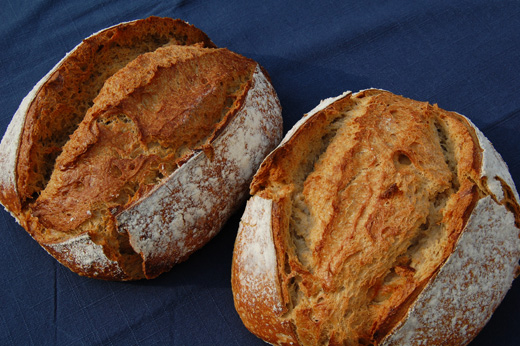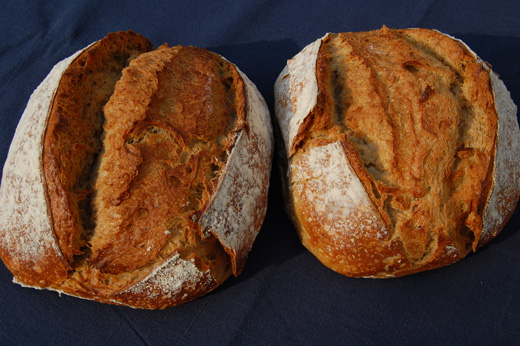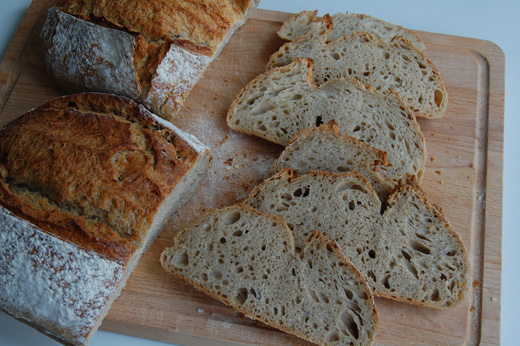Oxidising Fresh Flour, Over-Oxidising & Over-Mixing Dough

The subject of the need to oxidise fresh flour and also the need to introduce oxygen when mixing dough and the consequences of over doing it, which produces an inferior loaf both in appearance and flavour is a huge subject with nerdy-type of details. These details cover the effect of the gluten-forming proteins as well as non-gluten forming proteins, milling industry practices of chemically ageing flour with various agents, and also weakening agents allowing extendability of dough over elasticity, various problems with resulting doughs and things like discolouration of the loaf. I’m going to keep this post short (ok shorter than it could be) and therefore not cover minuscule details of these but two books that cover this subject well are How Baking Works by Paula Figoni and Bread by Jeffrey Hamelman, I would recommend them if you’re intrigued by the subject.
Green Flour (Fresh Flour)
If you’ve followed this site for a while you’ll already know how working with fresh flour can be problematic, especially if using levain fed on the same flour and using a liquid levain as I do. There are details of this in the post here, and how to overcome the problem, something I learnt through watching Roland dealing with his fresh flour and my own trials and errors. You can use green flour but it’s a bastard to work with and you can not treat it in the same way as aged flour (naturally or artificially aged) without suffering some kind of loss in the resulting loaf, be it in volume or texture of the crumb.
It is possible to work with green flour and produce a loaf with good results. It is possible to have a crumb that has a slight chew rather than the undesirable crumbling effect fresh flour has a tendency to produce, or to make a loaf risen well, giving a certain level of aeration to the crumb we’ve become accustom to. However, for these things to happen I’ve had to adapt my handling of the dough and the timings, dough temperatures becomes very important.

Oxidising
I experienced using Anne’s fresh flour which had been milled only 2 weeks with some of the problems I’ve mentioned above and then two months later using the same sack of flour kept in my baking room I felt the power of oxidisation and its effectiveness, changing the characteristics of the flour enabling me to treat the dough like any other stoneground flour. I talk about this in the post here.
Oxidising isn’t just important for the performance of the flour, according to Jeffrey it’s also important when mixing the dough. There is a need to add oxygen when initially mixing dough, but this addition of oxygen doesn’t need special treatment, in bakeries the mixing with the dough hook the large amounts of flour is sufficient and at home making small amounts using your hands is fine.
The initial oxygen is necessary for the overall performance of the gluten-performing proteins according to Jeffrey, and according to Debra Wink and Harold McGee this oxygen will be used quickly by microbes like yeast because it produces the most energy and also by aerobic lactic acid bacteria in sourdough.
The other importance of adding air when mixing dough is in creating the necessary air pockets, the air pockets later used, filled by carbon dioxide and steam to create lift through the rising and baking.

Over-Oxidising
OK, so ageing flour really does work, I had experienced it first hand but what happens when you over-oxidise it?
A flour can be over-oxidised in two ways, through the ageing of the flour, either naturally by time or using chemical agents, but the other way to over-oxidise dough is when mixing it and this is something Jeffrey talks about in detail in his Bread book.
Over-oxidising when mixing dough is really only a problem in bakeries using mixers but I’m guessing if you use a mixer at home the theory would be the same. Jeffrey says dough that has been over-oxidised has had a whiting effect, turning the dough from its original attractive creamy-white colour to a toothpaste white. Along with this chemical change there is also a loss of flavour in the finished loaf.

Left: amaretto 2011 Right: amaretto 2010
The loss of colour and flavour through over-oxidisation made sense when I made the two loaves on this post using the same variety of flour, amaretto, the flours were milled at different times. The loaf on the left is amaretto 2011 which was milled more recently than the loaf on the right amaretto 2010.
The older flour from amaretto 2010 was a bag I found in my baking room when sorting my flours last month, it was milled around the end of October. It produced a loaf just fine, it didn’t held as well as the other dough, amaretto 2011, but then it was a much lower protein so not surprising. The interesting thing about it was the paler colour both in the crust and the crumb.
These flours are both milled by Anne using the same sieve and although the resulting colour could possibly be attributed by more or less bran in the flour through milling it doesn’t explain the differences in flavour. This is why the over-oxidisation Jeffrey talks about creating a whiter and less pronounced wheat flavour loaf was of great interest to me when I saw this result.
The paler, and less pronounced flavour of the older amaretto flour is not really over-oxidised, but it is a much older flour than the younger amaretto flour milled at the beginning of this year. The reason this noticeable difference in colour and certainly in flavour has happen within a short period of time is because proper stoneground flour ages faster than your standard white flour (roller white).

The key reason for me to use good white stoneground flour like this is for its flavour, whiter colour in stoneground flour might be more attractive to some but as this test has shown it is of no interest to me.
When I tasted the crumb of the older paler amaretto it tasted of a nice wheat flavour but that flavour was overshadowed as soon as I tasted the younger version. Anne from the very beginning has said “tasting flour is like tasting wine” and this is a good example of it. The younger flour had maximum flavour impact, the amaretto flavour I’m use to, a greener-grassy stronger flavour. When Bikerboy had a slice of each this morning for his toast, he said unprompted that one tasted of normal bread and the other tasted of amaretto.
This rather narrow window between enough oxidisation to age flour for an easier time on the baker’s bench and then verging on too much oxidisation at the cost of some of its flavour is particularly so of properly stoneground flour, and this experiment was a useful insight into what Jeffrey was talking about generally.
My lesser pronounced flavoured amaretto loaf however, still had more flavour than any normal white flour (roller mill) which has no flavour since it’s stripped of it. This is why I believe bakers love their sourdough culture with normal white flour, giving back flavour, and why I say when you have a very flavoursome flour to lower the acidity level in the levain in order to let the flavour of the flour come through.
Note: The reason I mention on here proper stoneground flour is because there is flour out there called stoneground flour but it’s not, the flour has been passed through the stones on the way down to the rollers and then roller milled, it’s roller milled flour. I guess those millers feel they can ease their conscious with charging so much more money by passing through the stones in the beginning.
